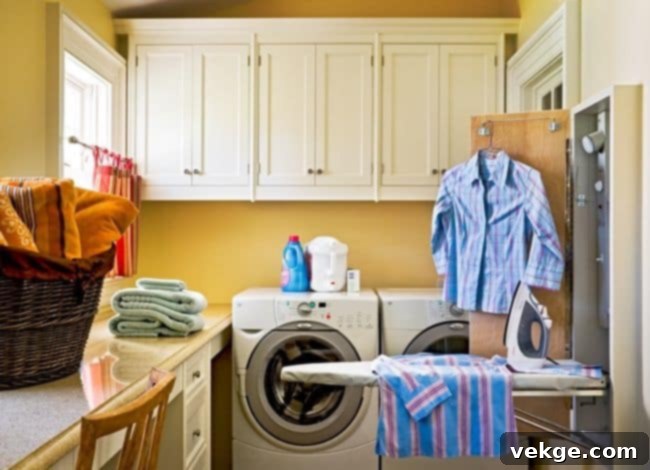Transform Your Laundry Room: The Ultimate Guide to Functional & Stylish Design
Often relegated to a forgotten corner or a dark basement, the laundry room is a highly functional space that deserves thoughtful attention in home design. Far from being merely a utility area, a well-planned and designed laundry room can significantly enhance daily living, transforming a mundane chore into a more enjoyable and efficient process. With careful consideration of its layout, aesthetics, and practical elements, a cluttered and unorganized space can be reimagined into a functional, stylish, and welcoming part of your home.
This comprehensive guide will walk you through essential factors and creative ideas to help you design a laundry room that not only meets your specific needs and preferences but also seamlessly integrates with your home’s overall aesthetic. Whether you’re planning a new build or looking to renovate an existing space, these insights will empower you to create the ultimate laundry oasis.
1. Optimize Your Laundry Room Layout for Efficiency
The foundation of any successful laundry room design lies in its layout. The way your space is configured directly impacts its functionality, flow, and overall efficiency. A strategic laundry room layout ensures that every task, from sorting dirty clothes to folding clean ones, can be performed with ease and without unnecessary steps.
Consider the “laundry cycle” when planning your layout:
- Arrival of Dirty Clothes: Where do hampers go?
- Sorting: Is there a dedicated surface or separate bins?
- Washing and Drying: Optimal placement of appliances.
- Pre-treating/Soaking: Is a utility sink readily available?
- Drying (Air): Space for hanging racks.
- Folding: A clear, comfortable countertop.
- Storage: Cabinets or shelves for supplies and folded items.
Common layout options include galley-style (appliances and countertops along one wall or two parallel walls), L-shaped (good for adding a sink or folding area), and U-shaped (ideal for larger rooms, offering maximum counter and storage space). For smaller homes, a stackable washer/dryer unit in a closet or a European-style laundry within a bathroom or kitchen might be the best solution. Always measure your space accurately and consider the swing of doors (both room and appliance) to ensure smooth operation.
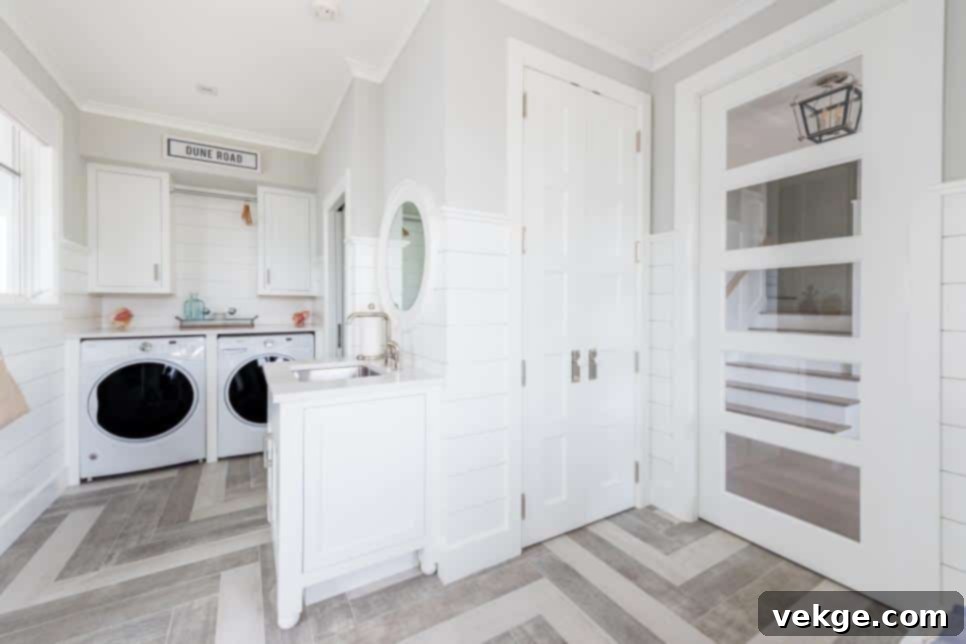
2. Balance Form and Function for a Practical & Beautiful Space
A truly exceptional laundry room design doesn’t sacrifice aesthetics for utility, or vice versa. It’s about achieving a harmonious balance where the space is not only visually appealing but also incredibly functional and efficient. “Form” refers to the aesthetic appeal – the style, colors, materials, and overall design elements that make the room inviting. “Function” encompasses the practical aspects – how well the space facilitates laundry tasks, its ergonomics, and ease of use.
To achieve this balance, consider how design choices can support functionality. For example, durable, easy-to-clean surfaces (form) contribute to a hygienic and low-maintenance environment (function). Strategically placed storage (function) can be beautifully integrated with stylish cabinetry (form). Ensuring proper lighting (form) illuminates work areas effectively (function). By prioritizing both aspects, you create a laundry room that you’ll enjoy spending time in and that makes laundry day feel less like a chore and more like a streamlined process.
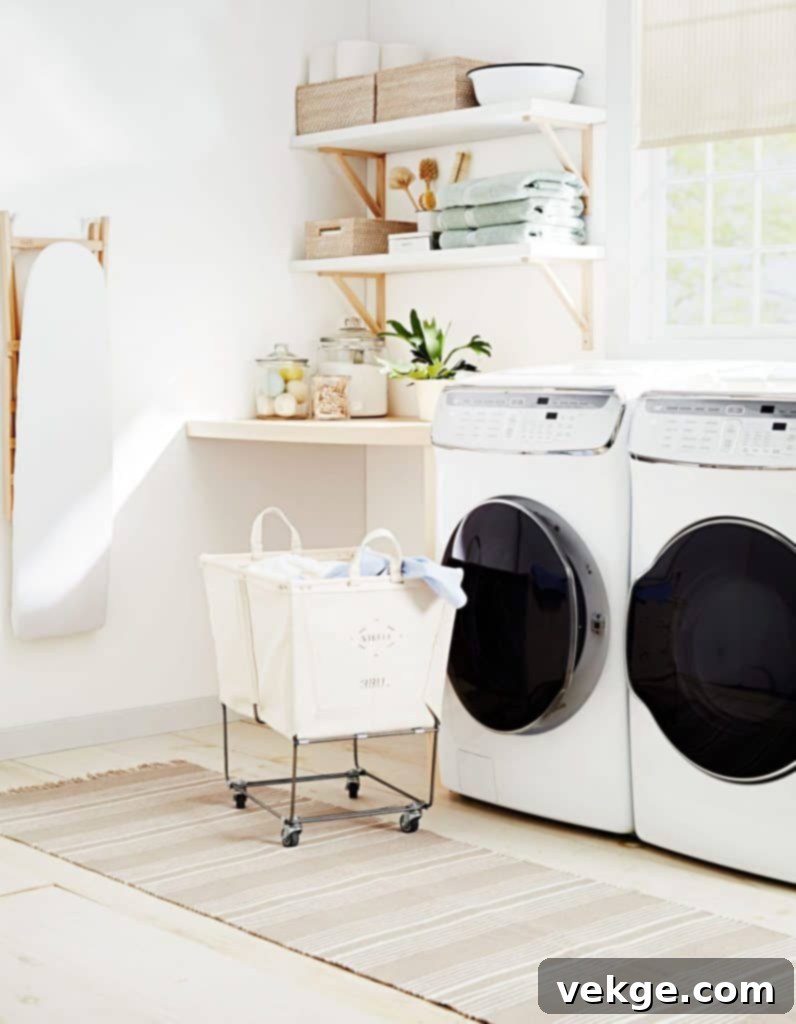
3. Smart Storage Solutions for an Organized Laundry Room
Effective laundry room storage is paramount to maintaining an organized, clutter-free, and highly functional space. Without adequate storage, laundry essentials like detergent, dryer sheets, stain removers, and cleaning supplies can quickly turn your utility room into a chaotic mess, making laundry tasks more frustrating and time-consuming. Maximizing storage can also free up valuable counter space for folding and sorting.
Consider a variety of storage options to suit different needs:
- Cabinets: Both upper and lower cabinets provide concealed storage for detergents, cleaning supplies, and less attractive items, maintaining a clean visual line.
- Open Shelving: Ideal for frequently used items, decorative elements, or neatly folded towels.
- Drawers: Perfect for small items, lint traps, or even pull-out hampers for sorting dirty clothes.
- Hanging Rods/Drying Racks: Essential for air-drying delicate garments or hanging freshly ironed shirts. Options range from wall-mounted collapsible racks to ceiling-mounted systems.
- Folding Table or Countertop: A dedicated surface significantly streamlines the folding process. If space is limited, consider a pull-out or fold-down option.
- Baskets & Bins: Use stylish baskets or bins for organizing odds and ends, lost socks, or sorting laundry.
- Vertical Storage: Utilize tall, narrow spaces with pantry-style cabinets or shelving units for brooms, mops, and other cleaning tools.
By integrating these thoughtful storage solutions, your laundry room will remain tidy, and all your essentials will be within easy reach.
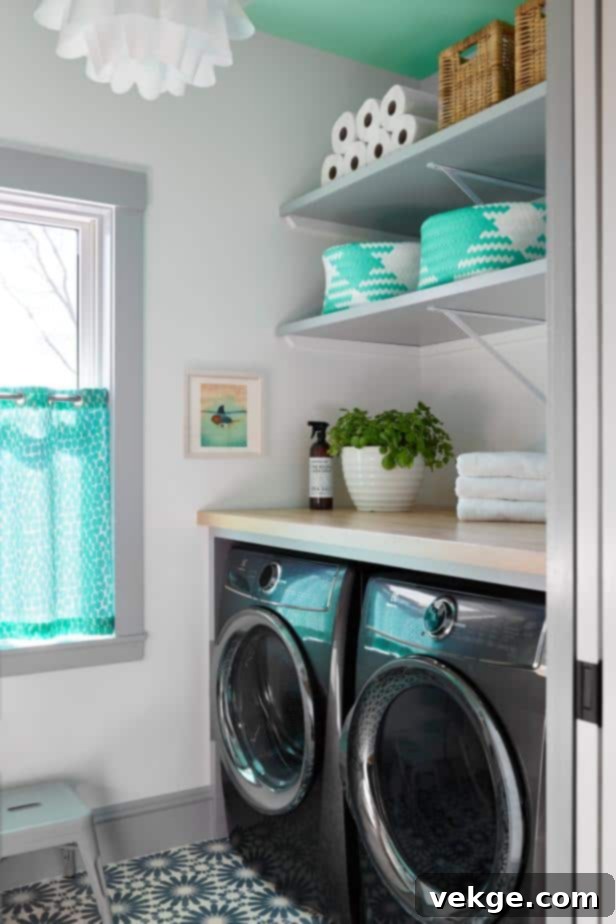
4. Illuminate Your Space with Thoughtful Laundry Room Lighting
Proper laundry room lighting is not just about aesthetics; it’s a critical component of functionality and safety. A well-lit laundry room makes every task easier, from accurately sorting whites from colors to spotting stubborn stains, and even folding clothes without shadows. Poor lighting can lead to eye strain, errors, and a generally unwelcoming atmosphere.
Aim for a combination of natural and artificial light:
- Natural Light: If possible, incorporate a window or skylight. Natural light brightens the space and helps with accurate color perception, which is crucial for laundry tasks.
- General Ambient Lighting: Overhead fixtures like recessed lights, flush-mounts, or semi-flush mounts provide overall illumination. Choose bright, clear bulbs (daylight temperature is often preferred for utility spaces) to simulate natural light.
- Task Lighting: Crucial for work areas. Install under-cabinet lighting above countertops where you’ll be sorting, folding, or pre-treating stains. A dedicated light over a sink or ironing station can also be very beneficial.
- Accent Lighting: While less critical in a utility space, accent lighting can highlight open shelving or decorative elements, making the room feel more intentional and stylish.
Ensure that lighting is evenly distributed and minimizes shadows, creating a bright and productive environment for all your laundry needs.
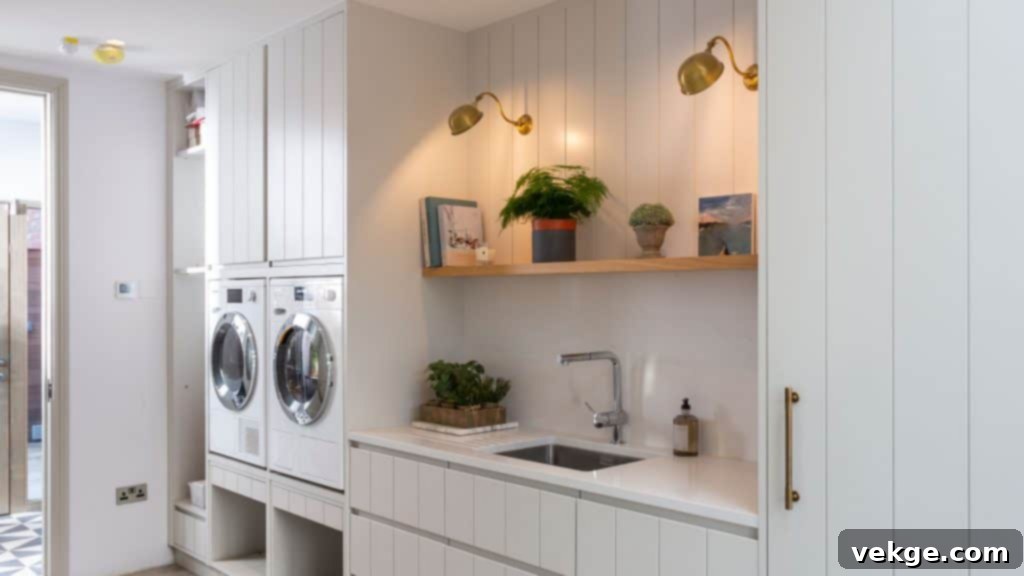
5. The Power of Color: Crafting Your Laundry Room’s Atmosphere
The use of color in your laundry room can profoundly impact its overall feel and atmosphere. Far from being just a utilitarian space, your laundry room can be a vibrant, calming, or energizing area, depending on your chosen color scheme. The right colors can make the space feel more inviting, comfortable, and even larger.
While neutral colors like white, gray, and beige remain classic and popular choices for their ability to make a space feel bright, clean, and spacious, don’t shy away from incorporating personality.
- Neutrals: Provide a timeless backdrop that complements almost any style and allows appliances and other elements to stand out. They are excellent for creating a clean, airy feel.
- Pops of Color: Introduce color through accent walls, vibrant cabinetry, colorful tiles, or accessories like laundry bins and artwork. This adds personality without overwhelming the space.
- Light & Bright: Lighter colors generally reflect more light, which is particularly beneficial in windowless or smaller laundry rooms, making them feel more open and cheerful.
- Cohesive Look: Choose a color palette that either mirrors or complements the aesthetic of adjacent rooms in your home, creating a seamless transition and a cohesive overall design.
- Mood Setting: Soft blues and greens can create a calm and serene environment, while brighter yellows or oranges can infuse energy and cheerfulness.
A well-chosen color palette not only enhances the visual appeal but also contributes to a more pleasant experience while tackling laundry chores.

6. Choosing the Right Laundry Room Door Style
The often-overlooked door style for your laundry room plays a crucial role in both functionality and the overall aesthetic integration with your home. The right door can save space, conceal clutter, reduce noise, and even enhance the room’s design.
Popular and practical door styles include:
- Bifold Doors: As mentioned, these are a favorite for laundry rooms. Bifold doors fold in on themselves, taking up minimal swing space, making them perfect for smaller rooms or closet laundries. They easily conceal the laundry area when not in use, yet offer full access when needed.
- Sliding Barn Doors: A trendy and stylish option, barn doors slide along a track outside the door frame. They require ample wall space for the door to slide open but add a significant design statement and save interior swing space.
- Pocket Doors: For ultimate space-saving, a pocket door slides directly into a wall cavity. This creates an uninterrupted wall space on either side, ideal for tight areas or rooms where furniture placement is critical. Installation can be more involved, however.
- French Doors: If your laundry room is a more open, integrated space or receives abundant natural light, French doors can add elegance and allow light to flow through. They require more swing space but create a beautiful visual connection.
- Traditional Hinged Doors: While simple, a standard hinged door works well in larger laundry rooms where swing space isn’t an issue. Consider a solid core door for better noise reduction.
When selecting a door, think about the space available, the level of concealment desired, and how the door integrates with your home’s architectural style and existing doors.
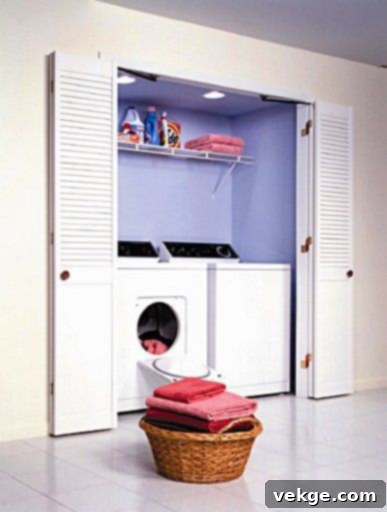
7. The Importance of Little Details in Laundry Room Design
It’s often the small, thoughtful additions that elevate a laundry room from merely functional to truly exceptional. Paying attention to these little details in your laundry room can significantly enhance convenience, organization, and the overall user experience, making laundry tasks feel less cumbersome.
Consider incorporating elements such as:
- Built-in Drying Racks or Hanging Rods: Beyond general storage, dedicated spots for air-drying delicates or clothes that can’t go in the dryer are invaluable. Wall-mounted, pull-out, or ceiling-mounted options save floor space.
- Built-in Ironing Board: As discussed in a later point, this saves space and makes ironing a breeze.
- Utility Sink: A small sink or dedicated utility sink is a game-changer for pre-treating stains, handwashing delicate items, rinsing out dirty mop heads, or even washing small pets.
- Waste & Recycling Bins: Integrate designated bins for trash, lint, and recycling (e.g., empty detergent bottles) to maintain tidiness and eco-friendliness.
- Pegboards or Slatwalls: These versatile systems can be installed on an empty wall to hang cleaning tools, small baskets, or decorative items, keeping them accessible and off countertops.
- Pull-out Hampers/Bins: Integrate these into cabinetry for easy sorting of dirty laundry (darks, lights, delicates) before washing.
- Decorative Touches: Don’t forget that a laundry room can also be beautiful! Add a small plant, some artwork, stylish containers for detergent, or a decorative rug to make the space feel more inviting and less sterile.
- Smart Home Integration: Consider smart appliances that can be controlled remotely, or smart lighting systems that automate your illumination.
These thoughtful additions streamline tasks and add a layer of comfort and efficiency to your laundry routine.

8. Ensure Proper Ventilation for a Healthy Laundry Room
Proper ventilation in a laundry room is not merely a recommendation; it’s a necessity for maintaining a healthy and safe home environment. Laundry appliances, especially dryers, generate significant heat and moisture. Without adequate ventilation, this moisture can accumulate, leading to several problems:
- Mold and Mildew Growth: High humidity creates an ideal breeding ground for mold and mildew, which can damage surfaces, fabrics, and pose health risks, particularly for those with allergies or respiratory issues.
- Musty Odors: Stagnant, moist air often leads to unpleasant, musty smells that can permeate your clothes and home.
- Damage to Structures: Prolonged exposure to humidity can cause deterioration of walls, ceilings, and cabinetry.
- Reduced Appliance Efficiency: Poor ventilation can make your dryer work harder and less efficiently, increasing energy consumption and wear and tear on the appliance.
To ensure proper airflow:
- Exhaust Fan: Install a high-quality exhaust fan that vents directly to the outside (not into an attic or crawl space). Ensure its CFM (Cubic Feet per Minute) rating is appropriate for the size of your room.
- Window: If your laundry room has a window, open it during and after laundry cycles to allow fresh air in and moist air out.
- Dryer Vent Maintenance: Regularly inspect and clean your dryer vent ductwork. Clogged dryer vents are a major fire hazard and severely reduce dryer efficiency.
By actively managing humidity, you’ll protect your home, your health, and your appliances, ensuring your laundry room remains fresh and functional.
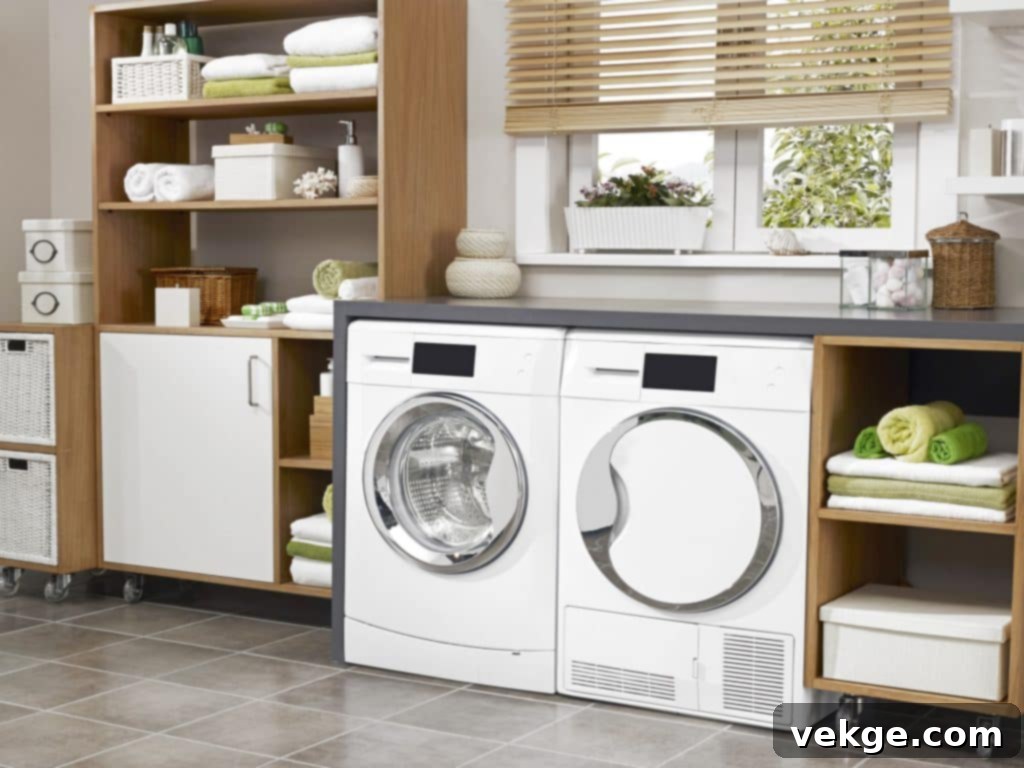
9. Plan for the Future: A Laundry Room That Grows With You
When embarking on a laundry room plan, it’s wise to consider not just your current needs but also potential future requirements. Designing with foresight can save you from costly and inconvenient remodels down the line. Think about how your household might evolve over the years.
- Family Growth: Will you have more children or elderly parents moving in, potentially increasing laundry volume and requiring more storage or specialized care?
- Aging in Place: Consider accessibility. Can appliances be raised for easier loading/unloading? Is there enough clear floor space for a wheelchair if needed in the future?
- Changing Habits: Do you anticipate needing a dedicated space for hobbies like sewing or crafting, which could share the laundry room?
- Resale Value: A thoughtfully designed and adaptable laundry room can be a significant selling point.
- Flexible Storage: Opt for modular storage solutions that can be easily reconfigured, added to, or adjusted as your needs change.
- Plumbing and Electrical Rough-ins: Even if you don’t install a sink or extra outlets now, having the rough-ins in place can make future additions much simpler.
By incorporating flexibility and anticipating future demands, you create a laundry room that remains efficient, practical, and enjoyable for many years to come, avoiding the need for another major overhaul.

10. Where to Put It: Deciding on the Best Laundry Room Location
The location of your laundry room within your home is a fundamental decision that impacts convenience, noise levels, and plumbing logistics. There’s no single “best” location; it depends on your lifestyle, home layout, and priorities.
Consider the pros and cons of various common locations:
- Near Bedrooms (Upstairs):
- Pros: Most convenient, as the majority of laundry originates from bedrooms and bathrooms. Reduces the need to carry heavy baskets up and down stairs.
- Cons: Potential for noise disruption if not well-insulated. Requires robust plumbing and waterproofing to prevent leaks from damaging lower floors.
- Main Floor (Mudroom/Kitchen Area):
- Pros: Good accessibility, especially if main living occurs on this floor. Can be integrated into a mudroom for a dual-purpose entry point. Easier access to a utility sink.
- Cons: Can be noisy if close to living areas. May take up valuable space on the main floor.
- Basement:
- Pros: Excellent for noise isolation; out of sight, out of mind. Often ample space for a large laundry room with extra storage. Plumbing is typically easier.
- Cons: Least convenient, requiring significant carrying of laundry up and down stairs. Basements can be damp, requiring extra ventilation and possibly a dehumidifier.
- Garage:
- Pros: Good for noise isolation and containing mess. Generally ample space.
- Cons: Often unheated/uncooled, making it less comfortable. Can be dusty or prone to dirt. Less convenient access from living areas.
- Closet Laundry:
- Pros: Ultimate space-saver, integrates into existing rooms.
- Cons: Very limited space for folding, storage, or a sink.
When deciding, carefully weigh convenience against noise, space, and plumbing requirements to choose the ideal spot for your household’s needs.
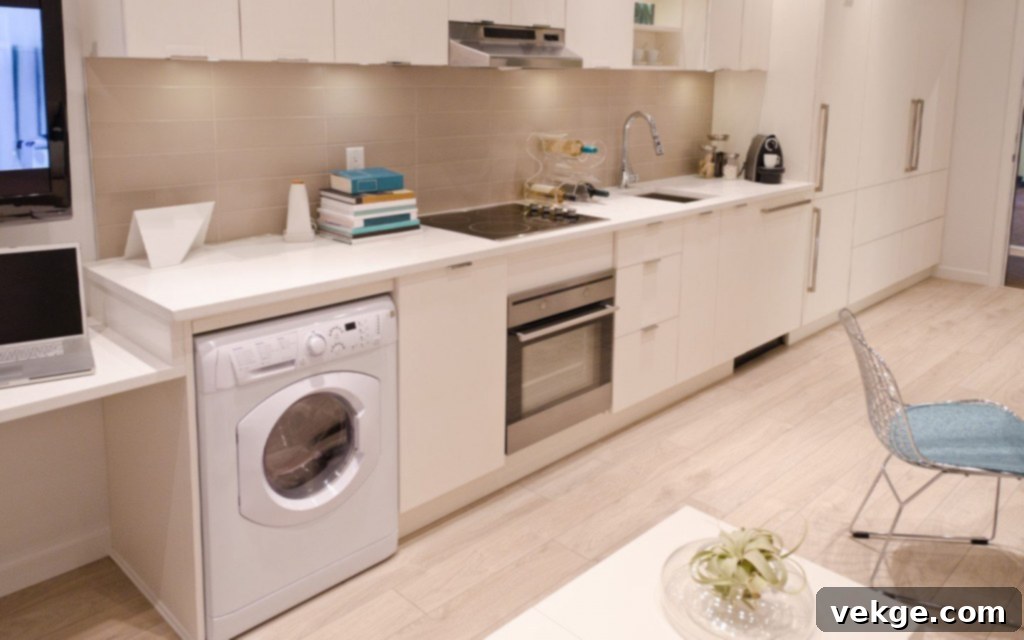
11. Thoughtful Appliance Choices for Your Laundry Room
The washing machine and dryer are the heart of any laundry room, making their selection a critical decision. Beyond just fitting the space, consider the size, type, energy efficiency, and features that best suit your family’s needs and lifestyle. Investing in the right appliances can save you time, money, and hassle in the long run.
- Capacity: Do you do large loads for a big family, or smaller, more frequent loads? Appliance capacity should match your typical laundry volume.
- Top-Loading vs. Front-Loading:
- Front-Loaders: More energy- and water-efficient, better at cleaning, generally gentler on clothes, and stackable (ideal for small spaces). Often offer pedestal options for ergonomic height.
- Top-Loaders: Can be more affordable, generally faster wash cycles, and easier to add clothes mid-cycle. Some newer models are high-efficiency without agitators.
- Energy Efficiency: Look for Energy Star certified models. While potentially a higher upfront cost, they lead to significant savings on utility bills over time.
- Smart Features: Modern appliances often come with Wi-Fi connectivity, allowing remote control, cycle notifications, and diagnostics.
- Noise Levels: If your laundry room is near living areas or bedrooms, choose quieter models with vibration reduction technology.
- Specialized Programs: For pet owners, consider washing machines with specialized pet hair removal cycles or features. Alternatively, using a pet safe detergent can also help prevent clogs and protect your machine. Always take necessary precautions to prevent expensive repairs and inconveniences by ensuring proper maintenance and cleaning of lint filters and drainage.
- Aesthetics: Appliances now come in a variety of colors and finishes to complement your laundry room’s design.
Careful consideration of these factors ensures you select appliances that make laundry day as efficient and stress-free as possible.
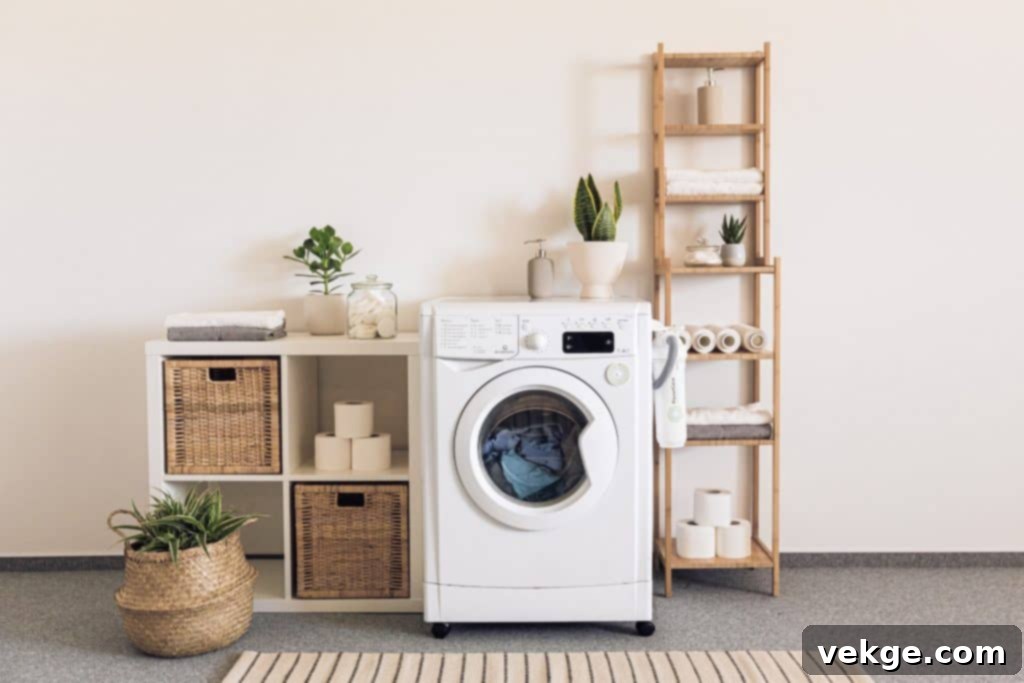
12. The Practicality of a Countertop or Sink
Adding a countertop or a sink to your laundry room is one of the most impactful decisions you can make to enhance its functionality and versatility. These elements provide dedicated work surfaces and water access that streamline numerous tasks.
- Utility Sink: A robust utility sink is invaluable. It’s perfect for:
- Pre-treating stubborn stains before washing.
- Handwashing delicate items that can’t go into the machine.
- Soaking heavily soiled garments.
- Rinsing out paintbrushes, dirty rags, or muddy shoes.
- Even bathing small pets, if designed appropriately.
Look for deeper basins and a high-arc faucet for maximum utility.
- Countertop Space: Dedicated countertop space adjacent to your washer and dryer is a game-changer for:
- Folding clothes fresh out of the dryer.
- Sorting laundry before washing.
- Holding laundry baskets, detergent, and other supplies.
- Temporarily staging items that need to be put away.
Consider durable, moisture-resistant materials like laminate, quartz, or butcher block. The height of the countertop should be ergonomic for comfortable standing tasks.
Integrating these features transforms your laundry room into a true multi-purpose workhorse, saving you trips to the kitchen or bathroom sink for messy tasks.
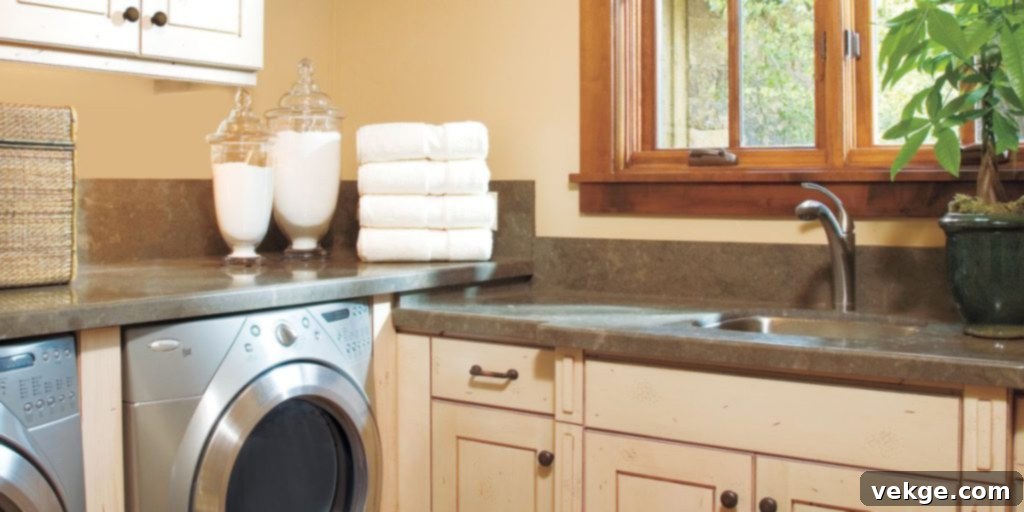
13. Space-Saving Solutions: Add a Built-In Ironing Board
For those who frequently iron, a built-in ironing board is an exceptionally practical and space-saving addition to any laundry room. It eliminates the need for a separate, freestanding ironing board that often takes up valuable floor space and becomes another item to store and retrieve. This simple feature significantly enhances convenience and helps maintain a clutter-free environment.
A built-in ironing board typically features:
- Fold-Away Design: It can be easily folded down from a cabinet or wall when needed and neatly tucked away when not in use. This discreet integration ensures your laundry room remains tidy and spacious.
- Accessibility: Always ready for action, a built-in board saves time and effort compared to setting up a traditional board.
- Types: Options range from wall-mounted units that pivot and fold, to drawer-mounted versions that slide out from under a countertop. Choose one that fits your space and ergonomic needs.
- Dedicated Spot: Having a fixed ironing station encourages more frequent ironing, keeping your garments crisp and neat.
This small detail can make a big difference, transforming a potentially awkward ironing chore into a quick and efficient task that is seamlessly integrated into your laundry routine.
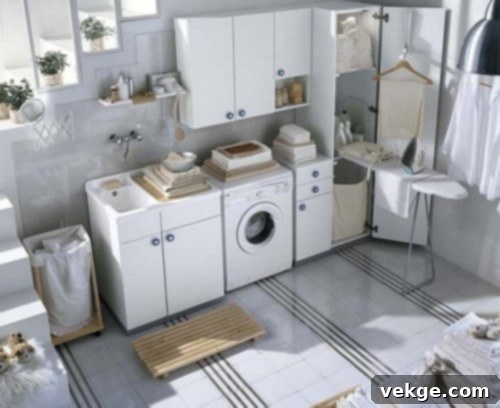
14. Maximizing Efficiency with Dedicated Countertops for Folding
The act of folding clothes is an integral part of the laundry process, and having dedicated countertops for folding in your laundry room can dramatically improve efficiency and make this task less of a chore. While a basic laundry room might lack this luxury, incorporating ample folding space is a hallmark of a truly functional design.
- Dedicated Flat Surface: A spacious, clear countertop provides an ideal area for systematically folding clothes, sorting items by person or type, and even performing light ironing tasks. This prevents clothes from being folded on beds or living room floors.
- Organization and Tidiness: With a designated folding area, clothes are less likely to accumulate in piles or create clutter. This helps keep the entire laundry room (and potentially other rooms) much tidier.
- Ergonomics: Design the countertop height to be comfortable for standing, reducing back strain during longer folding sessions. If you have front-loading machines, consider installing a countertop directly above them to create a seamless work surface.
- Material Durability: Choose countertop materials that are durable, easy to clean, and resistant to moisture, such as laminate, solid surface, or quartz.
- Additional Storage: The space beneath folding countertops can often be utilized for base cabinets, drawers, or pull-out hampers, further enhancing the room’s storage capacity.
By integrating dedicated folding countertops, your laundry room becomes a highly productive and organized workspace, transforming a common household chore into a more streamlined and comfortable experience.
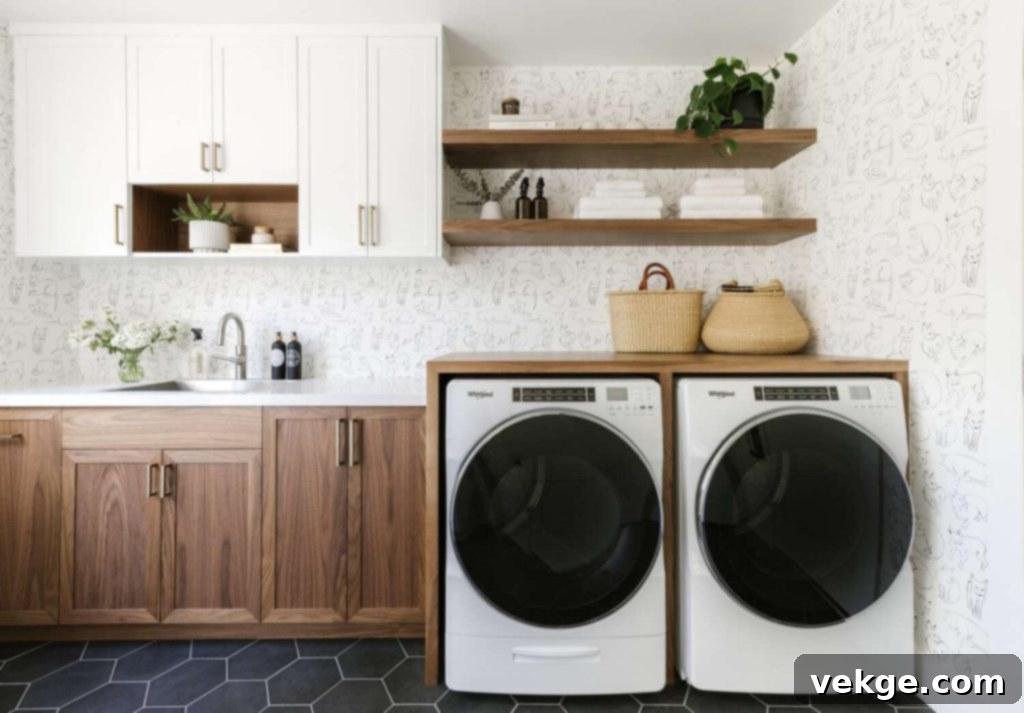
Conclusion: Design Your Dream Laundry Room
The laundry room, while often seen as a purely utilitarian space, has immense potential to be a highly functional, organized, and aesthetically pleasing part of your home. As one of the most frequently used rooms, investing time in its thoughtful design and planning can significantly improve your daily routine and overall home enjoyment. While the journey of deciding how to design and plan your ideal laundry room might seem overwhelming given the numerous factors to consider, the rewards of a well-executed space are invaluable.
From optimizing your layout for seamless workflow and implementing smart storage solutions to selecting the right appliances and paying attention to crucial details like lighting, ventilation, and even the subtle impact of color, every decision contributes to the final outcome. Whether you envision a dedicated, expansive laundry oasis or a cleverly integrated, space-saving nook, remember that a truly great laundry room is one that caters specifically to your household’s needs, making laundry day less of a burden and more of a streamlined, efficient process. We hope this comprehensive guide has illuminated the path, making your laundry room planning process not just easier, but also an exciting opportunity to enhance your home.
